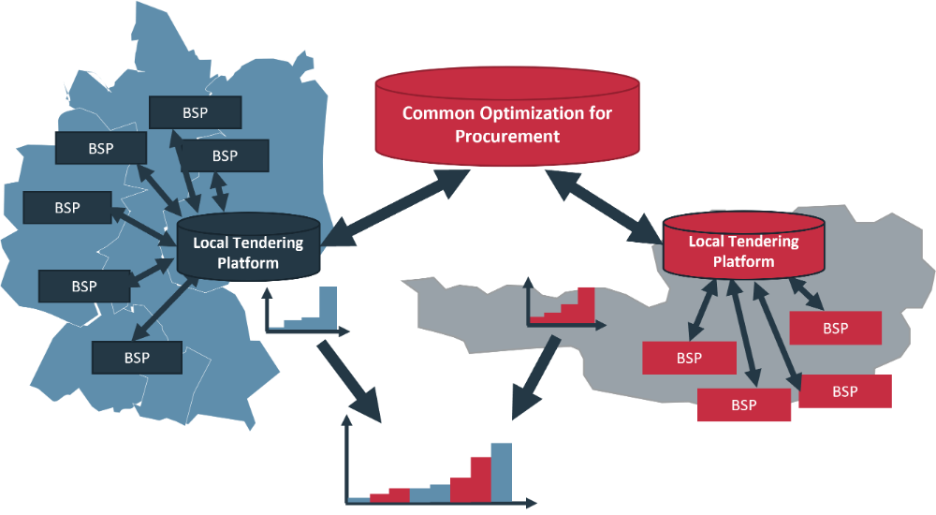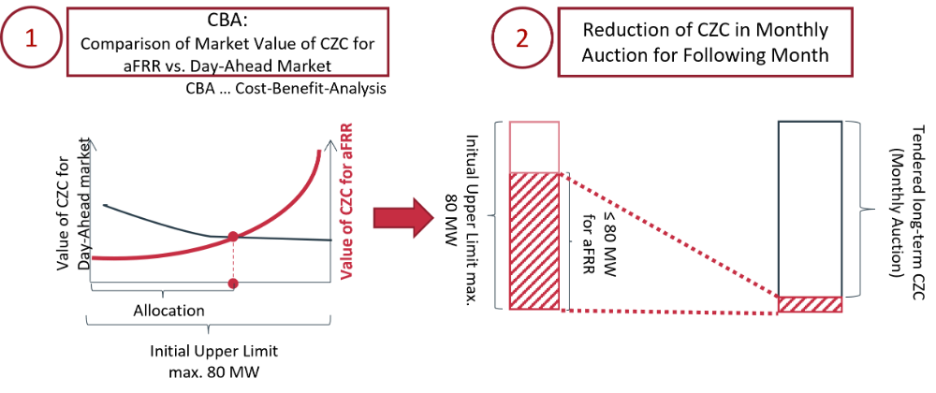Balancing capacity cooperation Austria / Germany
The balancing capacity cooperation for the common procurement of aFRR between APG and the German TSOs is based on a TSO-TSO model. For this, the respective TSOs remain responsible for dimensioning, prequalification, procurement and activation of aFRR. They also remain the single point of contact for balancing service providers which are connected within the respective load-frequency control area. This means that for balancing service providers in Austria APG’s tendering platform remains the main interface.
Common Procurement Optimization
Based on the dimensioning rules, the aFRR demand in Austria and Germany is procured via daily simultaneous (national) tenders. A common procurement optimization function (CPOF) determines the economically most efficient selection of bids, taking into account the CZC that has been allocated for the exchange of aFRR balancing capacity between Austria and Germany. This joint procurement can lead to situations where one control block procures more aFRR than needed to cover its demand, which means that the other, cooperating, control block can procure less. The total sum of procured aFRR capacity will, however, always suffice to cover local demands. As usual, the information about selected bids is published on the respective national tendering platforms.

Due to the joint procurement of aFRR, Austrian BSPs gain access to a larger market - without additional requirements for prequalification. In addition, the Austrian energy market as well as the entire energy system benefit from increased liquidity of the market and hence from a reduction of procurement costs.
Harmonization of Products and Market Rules
The joint procurement of aFRR capacity requires the products and tendering rules in Germany and Austria to be harmonized. Since 2017, within a first round of harmonization, the procurement has been changed from weekly to daily procurement and the validity periods have been reduced from peak and off-peak products to 4-hour-products. The currently valid terms and conditions for balancing capacity auctions can be found here. According to the provisions of the EBGL proposals for these changes have been submitted to market participants and stakeholders for consultation and to the relevant regulatory authorities for approval.
Allocation of Cross-zonal Capacity for the Exchange of aFRR Capacity
In order to perform a joint procurement of aFRR, TSOs need to allocate CZC for the exchange of aFRR capacities. This allocation allows cooperating TSOs to access the necessary aFRR that is connected to the cooperating control block at any time. The volume of CZC allotted for the exchange of aFFR between Austria and Germany is thus deducted from the tradable volume which is tendered in the monthly JAO-auction.
To determine the optimum allocation of CZC for the exchange of aFRR capacity, APG and the German TSOs developed a cost-benefit analysis (CBA) that compares the market value of CZC on the day-ahead market with the market value of CZC for the aFRR market. The CBA is performed before the monthly auction of CZC. For the initial phase of the joint aFRR procurement the maximum allocation of CZC is limited to 80 MW. Figure 2 illustrates the comparison of market values and the resulting allocation of CZC.

Release of Cross-zonal Capacity for the energy market
Following the monthly process to determine the allocation of CZC, the final volume of CZC is re-evaluated on a weekly basis. This means that before each GOT of the first aFRR capacity auction of a calendar week an additional CBA is performed. Analogous to the monthly CBA, the market value of allocated CZC for the aFRR market is compared with the market value of allocated CZC for the day-ahead market. In case the weekly cost-benefit analysis results in a lower optimum allocation, the difference between the monthly and weekly result will be returned to the intraday market. Figure 3 illustrates the monthly allocation process as well as the weekly re-evaluation and release of CZC.

CZC which is not needed for the exchange of aFRR capacity will be released according to the increase process of the Core region an returned to the intraday market. In case of a release of CZC, an "increase request" is put forward to increase the capacity volume of CZC available on the intraday market. However, whether this request is approved depends on the general situation of the transmission grid.
Settlement
The joint procurement of aFRR can lead to situations where one control block procures aFRR for the cooperating control block. To make sure that no TSO incurs additional costs, the costs of aFRR capacity which is procured for the cooperating control block must be settled between the TSOs. This TSO-TSO settlement is based on a model in which the most expensive bids which are selected in addition to those covering the local demand have to be compensated by the cooperating control block.
Publication
After each monthly CBA the CZC which is allocated for the exchange of aFRR capacity is published on the website of APG (here). After the weekly re-evaluation the values are updated to show the final CZC that is available for the exchange of aFRR capacity between Austria and Germany. The results of a balancing capacity auction are published within 30 minutes after gate closure time.
Ansprechpartner
Market Operations
Grid control
Information about the stability of the grid frequency, the control reserve market and essential basics of grid control.
Secondary control
Tenders for the secondary control reserve in the APG control area and frequently asked questions about secondary control.
